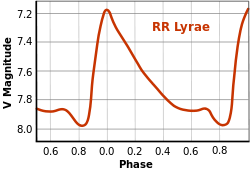RR Lyrae

RR Lyrae is a pulsating variable star in the constellation Lyra. It is the model for the variable stars known as RR Lyrae variables. It pulses over a short cycle of 13 hours, 36 minutes.[1] Each radial pulsation causes the radius of the star to vary between 5.1 and 5.6 times the Sun's radius.[2]
Stars of this type are often found in globular clusters, and used as standard candles to measure distances to other galaxies.
RR Lyrae and its type are pulsating stars of spectral class A (and rarely F), with a mass of around half the Sun's. It is thought they previously shed mass and consequently, they were once stars with similar or slightly less mass than the Sun, about 0.8 solar masses.
RR Lyrae stars pulse in a manner similar to Cepheid variables, so the mechanism for the pulsation is thought to be similar. The nature and histories of these stars is thought to be rather different. Unlike Cepheids, RR Lyraes are old, low mass, metal-poor "Population II" stars. They are much more common than Cepheids, but also much less luminous. The average absolute magnitude of an RR Lyrae is about 0.75, only 40 or 50 times brighter than our Sun.[3] Their period is shorter, typically less than one day, sometimes ranging down to seven hours.
The relationship between pulsation period and absolute magnitude of RR Lyraes makes them good standard candles for relatively near objects, especially within the Milky Way. They are extensively used in globular cluster studies, and also used to study chemical properties of older stars.
Knowing the period-luminosity relation for local RR Lyrae-type variable stars allows the distance of more distant stars of this type to be determined.[4] The distance of RR Lyrae remained uncertain until 2002 when the Hubble Space Telescope was used to fix its distance within a 5% margin of error. The result was 854 light-years (262 parsecs).[5] When combined with measurements from the Hipparcos satellite and other sources, the result is a distance estimate of 860 ly (260 pc).
RR Lyrae Media
RR Lyrae-type variable stars (not RR Lyr itself) close to the galactic center from the VVV ESO public survey
References
- ↑ Kolenberg K. et al 2011. Kepler photometry of the prototypical Blazhko star RR Lyr: an old friend seen in a new light. Monthly Notices of the Royal Astronomical Society 411 (2): 878–890 []
- ↑ Kolenberg K. et al 2010. An in-depth spectroscopic analysis of the Blazhko star RR Lyrae. I. Characterisation of the star: abundance analysis and fundamental parameters. Astronomy and Astrophysics 519: A64. [1]
- ↑ Layden A.C. et al 1996. (1996). "The absolute magnitude and kinematics of RR Lyrae Stars via statistical parallax". Astron. J. 112: 2110–2131. arXiv:astro-ph/9608108. Bibcode:1996AJ....112.2110L. doi:10.1086/118167. S2CID 8732647.
- ↑ Salaris, Maurizio & Cassisi, Santi 2005. Evolution of stars and stellar populations. Wiley, 181–18., ISBN 0-470-09220-3
- ↑ Benedict, G. Fritz et al 2002. Astrometry with the Hubble Space Telescope: a parallax of the fundamental distance calibrator RR Lyrae. The Astronomical Journal 123 (1): 473–484. [2]

